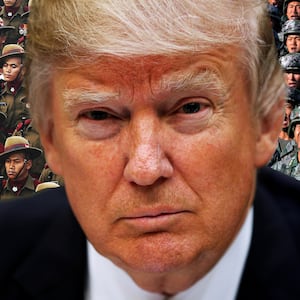KARACHI—The battle raged for hours between two nuclear powers on Monday, fought in a contested valley high in the legendary Karakoram mountain range. But the weapons used were as primitive as they were brutal: iron rods wrapped in barbed wire, bare fists, and anything that came to hand. When it was over, India counted 20 of its soldiers dead, some of them forced into a river. China acknowledged the clash, but gave no casualty count or details.
The incident marked a grave escalation in a decades-old high-altitude stand-off that had been intensifying in recent weeks, and suggests a Chinese strategy for which neither India nor the United States have a good answer: one of provocation, and incremental pushes, constantly testing resolve.
India at first said three of its troops were killed, but in a statement issued later on Tuesday the Indian Army said that 17 more critically injured succumbed to their injuries. Chinese foreign ministry spokesman Zhao Lijian said Indian troops "crossed the border line twice... provoking and attacking Chinese personnel, resulting in serious physical confrontation between border forces on the two sides.”
ADVERTISEMENT
As the BBC reported, Indian Foreign Minister Subrahmanyam Jaishankar said China tried to erect a structure inside Indian territory, while China's Wang Yi said Indian troops attacked first. But in a phone call both men promised not to escalate the situation. It was the first deadly clash at the disputed border for at least 45 years.
Indian Prime Minister Narendra Modi declared his soldiers’ deaths "will not be in vain.”
"India wants peace but when provoked, India is capable of giving a fitting reply, be it any kind of situation," Modi said in a televised address on Wednesday.
U.S. President Donald Trump offered to mediate, but both Beijing and New Delhi quickly rejected that possibility, as diplomats knew they would. And the American position—or lack of it—suggests just how weak the Trump administration’s position really is in this part of the world.
THE BUILD-UP
Tensions along the China-India border started escalating early last month when Chinese soldiers, ignoring verbal warnings from India, entered the disputed territory of Ladakh and erected tents and guard posts. Since then, thousands of soldiers from the two countries have been facing off just a few hundred meters from each other in the valley of the Galwan River more than two miles above sea level.
The proximate cause of the flare-up is believed by observers to be New Delhi's plan to build infrastructure projects along the edge of Chinese-claimed territory. India's construction of roads and air strips along the 4,056 kilometer poorly demarcated Line of Actual Control (LAC) eventually established decades after the 1962 Sino-Indian War raised eyebrows, and ire, in Beijing.
While China claims some 90,000 square kilometers of territory in India's northeast, including the Indian state of Arunachal Pradesh with its traditionally Buddhist population, India blames China for occupying 38,000 square kilometers of its territory in the Aksai Chin Plateau in the western Himalayas, including part of the Ladakh region.
A major reason behind strained Sino-India relations has been the exiled Tibetan spiritual leader, Dalai Lama, who fled his homeland in 1959 during an aborted uprising against Chinese rule. India hosted the Dalai Lama, who established a self-declared government-in-exile in the northern Indian town of Dharmsala, where thousands of Tibetans have settled.
The blame game over trespassing along the disputed border is played out through media on both sides. At present the most contentious issue is the strategic bridge being built by India near Daulat Beg Oldi, the last military post south of the Karakoram Pass. The bridge is the part of Darbuk-Shyok-Daulat Beg Oldi road, which will enhance India's strategic advance and access in the disputed region bordering China. Beijing's rapid military mobilization is aimed at deterring India's planned strategic access along LAC in Ladakh region.
In the current Sino-India border standoff, Beijing looks offensive and aggressive; New Delhi seems defensive and restrained, and the United States appears to be eyeing the developing situation as a silent spectator.
A FULL-BLOWN WAR?
India wants to complete the infrastructure projects for its rapid military mobilization and strategic advance in the Ladakh region. China is increasing maximum pressure to force India to stop the construction activity.
China has proved itself a dominant power by intruding several kilometers into the territory claimed by India along the LAC in the Ladakh region and by building bunkers there. Could the first clash lead to a full-fledged war between China and India?
Experts believe that with the Monday clash a crisis that was well on its way to de-escalating did an abrupt about face and brought China and India closer to war than at any other time in quite a few years. But, the experts do not see the skirmish leading to a full-scale conflict between the two nuclear-armed neighbors, and reports that despite the carnage no shots were fired suggests just how careful both sides are to avoid such a conflagration.
"A conflict is highly unlikely," Michael Kugelman, the deputy director and senior associate for South Asia at the Wilson Center in Washington told The Daily Beast.
"Neither side wants or can afford a war, and especially amid the coronavirus pandemic,” Kugelman said. “India, in particular, as the less powerful state won't want to risk a conflict. Eventually the two sides will deescalate. Still, there's no way that they will quickly climb down the ladder after a high-fatality incident like this one. Both sides will feel pressure to escalate, but both, and especially India, will need to be careful not to take measures that increase the possibility of miscalculation."
THE COUNTERWEIGHT?
Under President Barack Obama, the U.S projected India as a counterweight to China. But under the Trump administration, U.S policy witnessed a major shift vis-a-vis India. Last year, Donald Trump pushed New Delhi to the sidelines and initiated a peace process with the Afghan Taliban assigning Pakistan—India's arch rival—the key role facilitating U.S.-Taliban peace talks. And finally, Washington signed an exit deal with the Taliban on February 29. India was shut out of the whole two-year-long peace negotiations.
Now Trump has eschewed what India might have expected to be his role as a strong ally.
"Typically in these crises the U.S. stays quiet,” says Kugelman. “I would imagine that we could see the U.S. scale up its intelligence support to India to better enable New Delhi to know the troop positions of Chinese soldiers along the border,” but “the U.S. lacks the bandwidth to do anything else. The Trump administration is completely consumed by the coronavirus and its reelection campaign.”
Even so, says Kugelman, “I don't think we should underplay how significant this crisis is for Washington,” adding, "This is a case of Washington's top rival sparring with one of the biggest U.S. partners in the Indo-Pacific. The U.S. government is sure to be paying close attention, and it can't afford to look away."
Beijing has warned New Delhi to stay away from the U.S.-China rivalry. Beijing asked India to be careful not to include the U.S. factor in its handling of any problem in its relations with China, "otherwise it will only complicate the issue," China said in an article in the state-owned Global Times.
"The offer of U.S. mediation is unnecessary and the last thing both sides could use. China and India have the ability to resolve their problems, and there is no need for any third-party intervention," said the article. "If in a new Cold War, India leans toward the U.S. or becomes a U.S. pawn attacking China, the economic and trade ties between the two Asian neighbors will suffer a devastating blow. And it would be too much for the Indian economy to take such a hit at the current stage."






